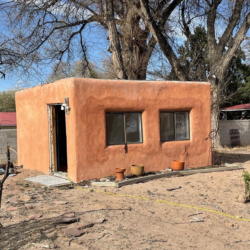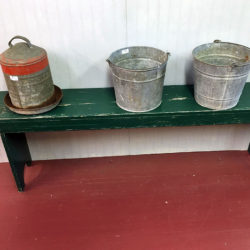Quimper Pottery – Collector Interview
I’m thrilled to have another guest blog post, this time from a collector of Quimper pottery, Faith Hague.
Faith sells her wonderful vintage & antique finds at the Camden Merchants Showcase in Camden, ME. Faith shares the story behind her collection and some helpful resources for starting your own collection.
As I know nothing about this festive pottery I was happy to learn more from Faith who has been collecting for sometime. First, a little background on the origin of this pottery. The village of Quimper (in Brittany, France) was settled in the fifth century by Celts at the juncture of two rivers (Odet and Steir). The Celtic word for such a juncture is kemper. Sometime later the name was changed to Quimper but the pronunciation remained the same. This info is according to Ann Marie O’Neill’s book.
1. What got you started with your collection?
In high school I spent two weeks with a family outside of Paris. Maman had a small collection of Quimper plates that she used for serving lunch and I fell in love with them. Once I started shopping for the pottery at home, I gained a real appreciation for how unique each handpainted piece is, with its own quirks and charm.
2. Where do you find your pieces? Any particular find that stands out in your mind?
At first, finding Quimper turned out to be a real treasure hunt, pieces were few and far between. I bought my first piece at a farm auction in Iowa 25 years ago. Then when ebay arrived on the scene, I went on a bit of a crazy shopping spree. The first piece I bought online was a heart-shaped dish from a seller in Hawaii and it arrived in our mailbox–intact, luckily–in a flimsy cardboard frozen shrimp package which was still a bit stinky! After years spent loading our cupboards with beautiful pottery, one August night our house was hit by lightning and we lost almost everything in the resulting fire. Very few pieces of Quimper survived and those that did all have telltale scorching. After that loss I still collected, but bought fewer pieces and became much more selective.

A hodge-podge of Quimper forms and decor. The huge vase in the center survived our fire, but the side facing away is blackened.
3. How do you typically display your collection?
The plates look beautiful hung in pairs or groups on wall racks. I’ll use smaller pieces all over the house: pitchers for flowers or pencils, small bowls to catch coins and clips, and there’s always a platter full of fruit. It was made for everyday use so I try not to keep it stacked in my cabinets.

A wall rack filled with a variety of plates. Some of these are cracked and chipped, but they still display nicely.
4. Are there any elusive pieces you’re searching for still?
I’m always on the lookout for an unusual form or pattern that I’ve never seen before. Many people are familiar with the plates decorated with Breton figures (sujet ordinaire) surrounded with yellow and blue rings, but the factory (originating in Brittany, France in 1650) has made a wide variety of other patterns over the years. My Quimper bucket list includes finding a representative piece from each decor.
5. What types of pieces are you interested in collecting? Can you tell us about any of your favorite pieces?
The romantic in me is drawn to items in pairs, with couples. I recently found a match to a lonely heart-shaped cup and saucer set I had for years. My favorite piece is our cordial set, which was a gift from a friend after the fire. I love the character in the woman’s face, typical of the Ivoire Corbeille pattern. I’ve also had friends give me pieces that once belonged to their mother or grandmother, and they mean a lot to me. And I love the tough pieces that survived the fire!
There is a lot of information available about Quimper, both online and in print. The Quimper Collector’s Club publishes an informative newsletter and meets one a year (every other year in France): http://quimperclub.org/
Resources:
Some of these are out of print, but my favorite books on the topic are:
- Collecting Quimper Collections, by Joan Datesman
- Popular Quimper (Schiffer Book for Collectors), by Ann Marie O’Neill
- Quimper Pottery: A French Folk Art Faience, by Sandra V. Bondhus
- Quimper Pottery: A Guide to Origins, Styles, and Values, by Adela Meadows
The sweet side effect of collecting Quimper is that we’ve made some great friends–here and in France–as we chased after this pottery. A reminder of how small the world is: My friend in Brittany, Judy, who I first “met” on ebay (and who also happened to be a friend of my husband’s co-worker!) was having a dinner party a few years back and invited neighbors and their guest from America. That guest turned out to be my (now) sister-in-law, who had no idea Judy and I knew each other until the subject of Quimper pottery came up!
Le monde est petit!
![]()





